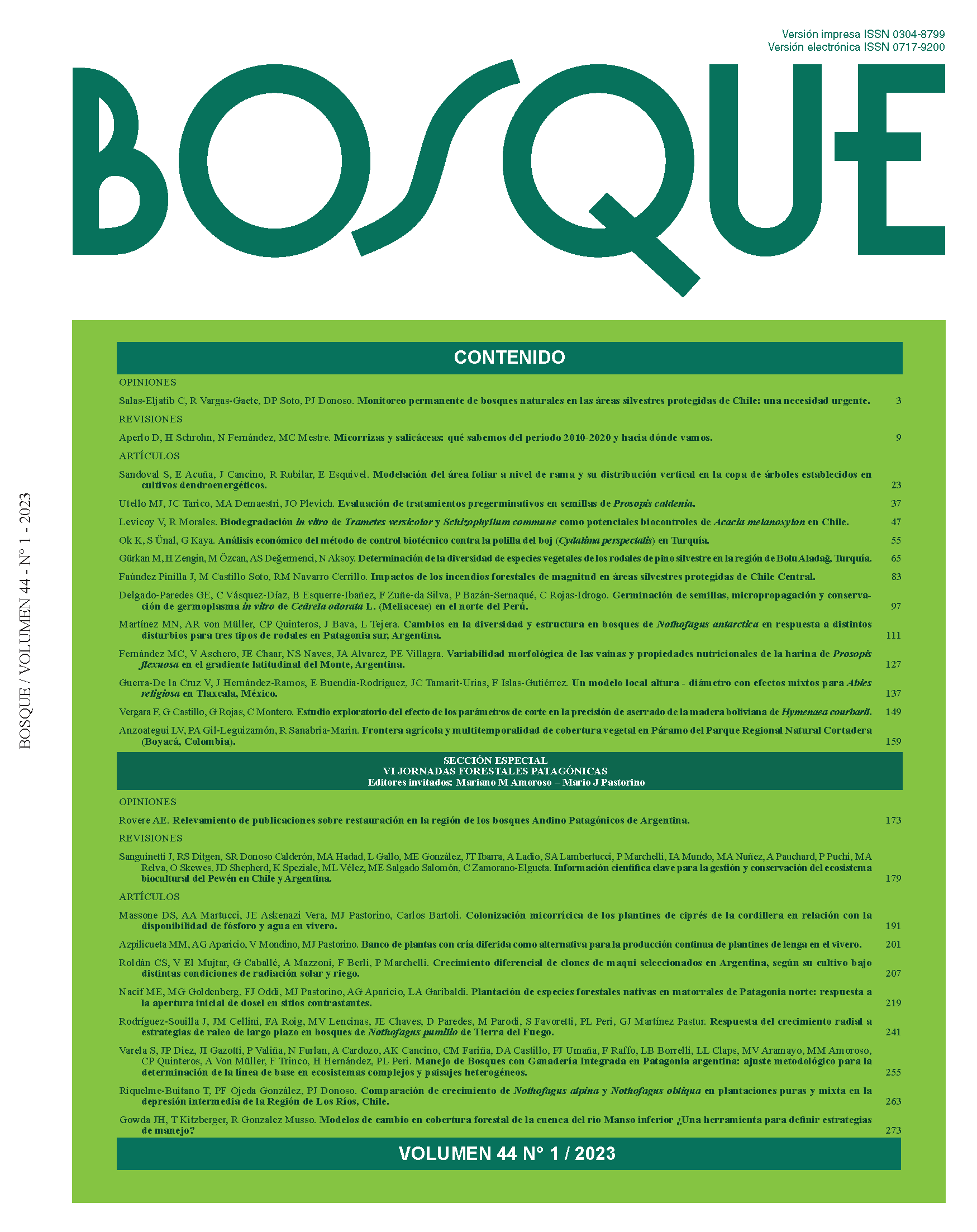Javier Sanguinetti
Administración de Parques Nacionales, Parque Nacional Lanín, San Martín de los Andes, Argentina.
Rebecca S Ditgen
Mercer University, Biology Department, Macon, USA.
Sergio R Donoso Calderón
Universidad de Chile, Facultad de Ciencias Forestales y de la Conservación de la Naturaleza, Laboratorio de Bosques Mediterráneos, Santiago, Chile.
Martín A Hadad
CIGEOBIO (CONICET-UNSJ), Laboratorio de Dendrocronología de Zonas Áridas, San Juan, Argentina.
Leonardo Gallo
INTA-CONICET, Instituto de Investigaciones Forestales y Agropecuarias Bariloche (IFAB), Bariloche, Argentina.
Mauro E González
Universidad Austral de Chile, Facultad de Ciencias Forestales y Recursos Naturales, Instituto de Conservación, Biodiversidad y Territorio, Centro de Ciencia del Fuego y Resiliencia de Socioecosistemas (FireSES), Laboratorio de Ecología de Bosques, Valdivia, Chile.
J Tomás Ibarra
Pontificia Universidad Católica de Chile, Co-Laboratorio ECOS (Ecosistema - Complejidad - Sociedad), Centro de Desarrollo Local (CEDEL) & Centro de Estudios Interculturales e Indígenas (CIIR), Villarrica, Chile; Cape Horn International Center for Global Change Studies and Biocultural Conservation (CHIC), Puerto Williams, Chile; Pontificia Universidad Católica de Chile, Facultad de Agronomía e Ingeniería Forestal & Center of Applied Ecology and Sustainability (CAPES), Santiago, Chile.
Ana Ladio
CONICET-UNCo, Instituto de Investigaciones en Biodiversidad y Medio Ambiente (INIBIOMA), Grupo Etnobotánica, Bariloche, Argentina.
Sergio A Lambertucci
CONICET-UNCo, Instituto de Investigaciones en Biodiversidad y Medio Ambiente, (INIBIOMA), Grupo de Investigaciones en Biología de la Conservación, Bariloche, Argentina.
Paula Marchelli
INTA-CONICET, Instituto de Investigaciones Forestales y Agropecuarias Bariloche (IFAB), Bariloche, Argentina.
Ignacio A Mundo
IANIGLA – CONICET, Laboratorio de Dendrocronología e Historia Ambiental, Mendoza, Argentina; Universidad Nacional de Cuyo, Facultad de Ciencias Exactas y Naturales, Mendoza, Argentina.
Martín A Nuñez
CONICET-UNCo, Instituto de Investigación en Biodiversidad y Medio Ambiente (INIBIOMA), Bariloche, Argentina; University of Houston, Department of Biology and Biochemistry, Houston, USA.
Aníbal Pauchard
Universidad de Concepción, Facultad de Ciencias Forestales, Laboratorio de Invasiones Biológicas, Concepción, Chile; Instituto de Ecología y Biodiversidad (IEB), Concepción, Chile.
Paulina Puchi
Università degli Studi di Padova, Dipartimento Territorio e Sistemi Agro-Forestali (TeSAF), Padova, Italia; Forest Modelling Lab., Institute for Agriculture and Forestry Systems in the Mediterranean, National Research Council of Italy (CNR-ISAFOM), Perugia, Italy.
María A. Relva
CONICET-UNCo, Instituto de Investigaciones en Biodiversidad y Medio Ambiente (INIBIOMA), Grupo de Investigaciones de Ecología en Ambientes Antropizados, Bariloche, Argentina.
Oscar Skewes
Universidad de Concepción, Facultad de Ciencias Veterinarias, Departamento de Ciencia Animal, Concepción, Chile.
John D Shepherd
Mercer University, Biology Department, Macon, USA.
Karina Speziale
CONICET-UNCo, Instituto de Investigaciones en Biodiversidad y Medio Ambiente, (INIBIOMA), Grupo de Investigaciones en Biología de la Conservación, Bariloche, Argentina.
María L Vélez
CONICET-CIEFAP, Área Fitopatología y Micología Aplicada, Esquel, Argentina.
María E Salgado Salomón
CONICET-CIEFAP, Área Fitopatología y Micología Aplicada, Esquel, Argentina.
Carlos Zamorano-Elgueta
Universidad de Aysén, Departamento de Ciencias Naturales y Tecnología, Aysén, Chile; Centro de Ciencia del Clima y la Resiliencia (CR2), Chile.
Abstract
The forest of Araucaria araucana (“pewen” in Mapuche language), with its associated species of the genus Nothofagus, is unique from an evolutionary, biological and sociocultural point of view. Due to the interdependence and interrelation with the Mapuche-Pewenche people, it is considered a biocultural ecosystem. This work is a comprehensive binational review of current scientific information applicable to its management and conservation. The scientific community contributed with significant advances in the knowledge of: a) the interrelationships within and significance of this biocultural ecosystem; b) the regional genetic diversity; c) the fire regimen, its main drivers, its role in forest dynamics, and the recovery capacity of biodiversity in the face of different burn severities; d) the ecological role of seed production and its unusual interactions with granivorous fauna and cavity nesters; e) the decline and death of the canopy, due to environmental stress and the emergence of new pewen pathogens; f) the consequences of the invasion of pines and exotic mammals that alter the biological interactions and the original ecological processes, and g) the effects of cattle ranching and overexploitation of firewood and pine nuts on ecological integrity and biodiversity. This knowledge is considered essential to strengthen policies and strategies for protection, conservation, and management of this ecosystem, which is endemic, rare, regionally threatened, and globally declared endangered. Considering the identified problems, it is imperative to achieve social empowerment of the Mapuche-Pehuenche people, intercultural respect, and enforcing public policies for the conservation and sustainable use of these forests.

